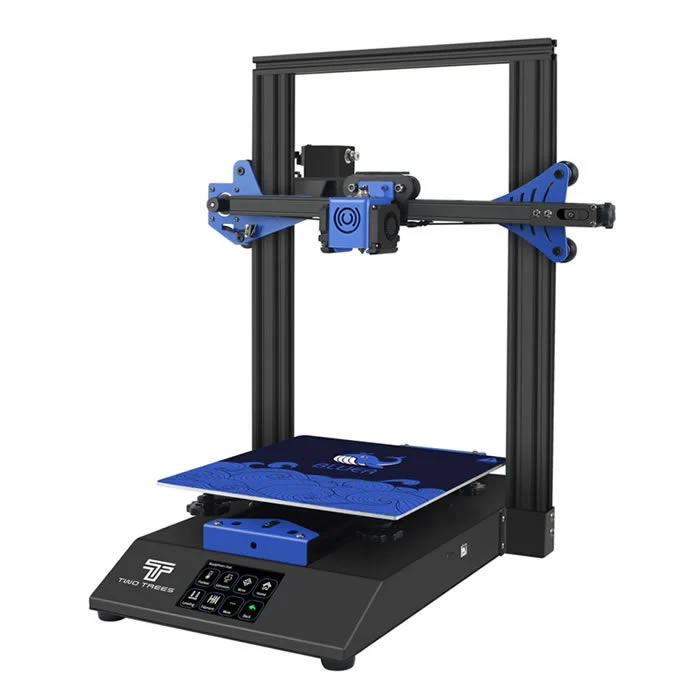Compare Bluer vs KP3S PRO V2
Comparison between the best 3D printers
Choose the best 3D printer at the best price. The cheapest 3D printers are here.
Buy a 3D printer here with 3D Fila.
 |
 |
|
| Model | Bluer |
KP3S PRO V2 |
| Printing Material | Filament | Filament |
| Buy Filament for TwoTrees Bluer | Buy Filament forKingroon KP3S PRO V2 | |
| Estimated price | $169,00 | $229,00 |
| Manufacturer | TwoTrees | Kingroon |
| Release Year | 2019 | 2024 |
| Print Volume [mm] | 230x230x280 | 220x220x250 |
| Printer Size [mm] | 400x410x520 | 420x400x450 |
| Weight [kg] | 8 | 12,6 |
| Power Loss Recovery | YES | NO |
| Enclosed printer | NO | NO |
| Bed Leveling | Manual | Automatic |
| Filament End Sensor | YES | NO |
| Bed type | Heated | Heated |
| Power supply system | Bowden | Direct Drive |
| Standard nozzle | 0,4 | 0,4 |
| Maximum Nozzle Temperature [°C] | 260 | 260 |
| Maximum Bed Temperature [°C] | 100 | 100 |
| Maximum printing speed [mm/s] | 200 | 350 |
| Filament holder | YES | YES |
| Camera for supervision | NO | NO |
| Recommended filaments | PLA, PETG | PLA, PETG, TPU |
| Recommended slicers | Cura, Simplify, Slic3r | Cura, Orca Slicer |
| Maximum Resolution [mm] | 0,1 | 0,01 |
| Processor | MKS Robin Nano V1.2 + TMC2208 | |
| Display | Touchscreen TFT 3,5'' | LCD Mono |
| Power Supply | 240W | 300 W |
| Connectivity | SD / USB | USB-C / MicroSD / Ethernet |
| Operating systems | Windows, Mac, Linux | Windows, Mac, Linux |
| Date of registration in the system | 2021-09-20 | 2025-03-18 |
| Release date | 2019 | 2024 |
| Extra features | The Bluer offers interesting features such as automatic bed leveling, a 3.5-inch color touchscreen for easy operation, and a filament sensor to prevent print failures. It has a robust metal extruder and a generous 230 x 230 x 280 mm print volume, suitable for a variety of projects. The community mentions improvements made by Two Trees based on feedback, increasing its reliability. | The Kingroon KP3S Pro V2 is a high-speed FDM 3D printer with Klipper firmware, ensuring fast and precise prints. It features linear rails on all axes, a Direct Drive extruder with a 9.5:1 gear ratio, and an efficient ceramic heater. It includes an inductive sensor for automatic bed leveling, a PEI magnetic bed, a built-in accelerometer for vibration calibration, and Wi-Fi, Ethernet, and USB connectivity for remote control. |
| Support for multiple colors and materials (AMS and CFS) | NO | NO |
Notes * |
||
| Cost-benefit | 7 / 10 | 7 / 10 |
| Hardware | 2 / 10 | 0.9 / 10 |
| Tela | . | . |
| Print volume | 3 / 10 | 3 / 10 |
| Performance | 1 / 10 | 3 / 10 |
Conclusion |
| In comparing the TwoTrees Bluer and the Kingroon KP3S PRO V2, several factors come into play, including price, features, and performance. The TwoTrees Bluer stands out as a budget-friendly option with a decent print volume of 230x230x280 mm, making it suitable for a variety of projects. It offers useful features like a filament end sensor and manual bed leveling, which enhance its usability for beginners or cost-conscious users. Its lightweight design (8 kg) and the inclusion of a heated bed make it a solid choice for those looking to start with 3D printing without breaking the bank. However, its manual bed leveling can be a drawback for users seeking convenience. On the other hand, the Kingroon KP3S PRO V2, although it comes at a higher price point, offers significant enhancements in performance and features. It boasts faster maximum printing speeds and automatic bed leveling, which simplifies the setup process. The direct drive system provides a wider range of filament compatibility, including flexible materials, difficult to print with direct drive systems. Additionally, the KP3S PRO V2's superior resolution and advanced features like Wi-Fi connectivity and an LCD Mono display cater to more experienced users or those who prioritize speed and efficiency in their projects. Ultimately, the choice between these two printers will depend on the user's budget and specific needs. If cost is a primary concern and the user is just starting out in 3D printing, the TwoTrees Bluer is a commendable option. However, for those willing to invest more for better performance, features, and support for more complex projects, the Kingroon KP3S PRO V2 is a more future-proof choice. Each printer has its unique strengths, making them suitable for different user demographics and project requirements. |

